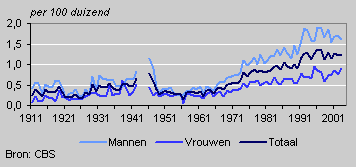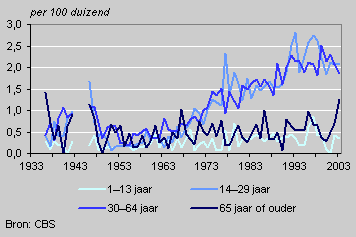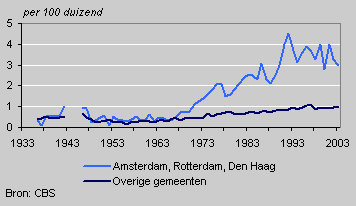Murder rate tripled

Between 1911 and 2003 7,695 people living in the Netherlands died as a result of murder or manslaughter.
The murder/manslaughter rate rose particularly strongly between 1965 and 1990.
Two hundred victims a year
Between 1911 and 1930 the number of victims of murder or manslaughter was on average nearly 20 a year. Between 1940 and 1970 it was around 40 a year. It rose subsequently to around 200 a year at the end of the nineties. Since then it has hardly risen further.
Victims of murder and manslaughter

No increase in murder rate since 1990
Murder and manslaughter have also risen substantially in relation to the number of inhabitants in the Netherlands. Until 1965 the relative number of victims of murder and manslaughter was low: around 0.4 per 100 thousand inhabitants. Between 1965 and 1990 the number of victims rose sharply to around 1.2 per 100 thousand in 1990. The murder rate has remained at this level since then.
Two-thirds of victims are men
Two out of three victims are men, one in three is a woman. This sex ratio in murder and manslaughter victims has hardly changed.
Until the beginning of the sixties young and old men had the same risk of being murdered. After that men in the age groups 14–29 and 30–64 years in particular ran risk of losing their life in this way. The murder rate rose to over 2.0 per 100 thousand men. For women the risk of being murdered was around the same for all age groups through the years.
Male victims by age

More murders in three largest cities
Inhabitants of Amsterdam, Rotterdam and The Hague run the highest risk of being murdered. In the years 2000–2003 there were on average 3.4 victims per 100 thousand inhabitants in the three largest Dutch cities. In The Hague the number was 2.6, in Amsterdam 3.2 and in Rotterdam 4.1 per 100 thousand inhabitants. In the rest of the Netherlands the rate was 0.9 per 100 thousand. These regional differences have been present since the mid sixties.
Victims of murder and manslaughter by municipality

Paul Nieuwbeerta (Netherlands Institute for the study of crime and law enforcement) and Ingeborg Deerenberg (Statistics Netherlands)